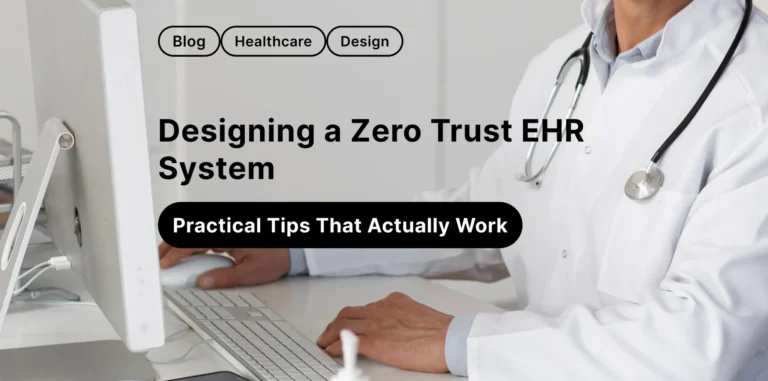Designing a Zero Trust EHR System: Practical Tips That Actually Work

During one of our online usability testing sessions, a doctor paused after trying to access a patient’s file. The system had asked for re-authentication (nothing unusual in a Zero Trust EHR System model) but the message was abrupt, unclear. She looked into the camera and said, “I understand why this is here, but it just made me feel like I did something wrong.”
Designing for healthcare is about making the right people feel trusted while they do high-stakes work. In healthcare, design has to do both: protect the data and protect the experience.
If you’re building an Electronic Health Record (EHR) system in 2025, here’s your north star: design for a Zero Trust EHR System from the inside out. Now we dig deeper into how to do that simply, beautifully, and securely.
1. Start with Identity, Not Access
In traditional systems, access is granted after login. In a Zero Trust EHR System system, identity is the starting point, and it’s never fully trusted. This builds patient and staff confidence, without overwhelming them.
Design Tip:
Create layered identity checkpoints:
- Biometrics + Password (2FA by default)
- Session-based identity verification (e.g., re-confirm before viewing sensitive records)
- Visual identity indicators (e.g., “Verified Clinician” badge next to user name)
2. Design for Minimum Necessary Access
Zero Trust means no one gets more access than they need. Show visibility as a design element, make limited views feel natural, not restricted.
Design Tip:
Use a role-based UI system:
- Nurses see only what they need (vitals, meds)
- Admins see billing and scheduling
- Doctors get full records with justification trails
3. Make Logging Look
Every action should be logged. But logs shouldn’t create friction.
Design Tip:
Use microinteractions that silently capture:
- Who viewed what
- When and where
- On what device
At the same time, show the user they’re protected:
“This session is monitored for patient safety and data integrity.”
4. Zero Trust ≠ Zero Usability
Security shouldn’t feel heavy. Think of Apple Face ID, it’s secure, fast, invisible. Your EHR should feel the same.
Design Tip:
- Auto-expire access gently: fade out screens instead of hard shutdowns
- Make re-authentication instant with biometrics or magic links
- Show progress indicators when pulling from locked-down sources
5. How to Improve UX While Applying Zero Trust
Zero Trust means treating every device, whether it’s a phone, tablet, or hospital terminal, as a potential threat.
Design Tip:
- Show session history visually (last logins, device types)
- Block outdated OS versions with a friendly notice:
“For your security, please update your device to access patient data.”
- Offer device fingerprinting with minimal disruption
6. Audit Becomes Part of the UX for Zero Trust
In traditional systems, audits live quietly in the background. In a Zero Trust model, they step into the interface.
Design Tip:
- Let users see their own access logs
- Give patients visibility too:
“Dr. Lim viewed your chart on May 22 to prepare for your visit.”
- Create clear audit dashboards for admins, with filters by date, role, or risk level
7. Default to Explainability
Users get frustrated when they hit a wall. Zero Trust creates more of those. But you can design through them. Let users understand the why, not just the no.
Design Tip:
- Replace errors with context:
“Access denied. This file is restricted to surgical teams.”
- Use iconography and animation to show blocked pathways gracefully
- Offer escalation buttons: “Request Access” or “Page Admin”
Conclusion
When we design for Zero Trust EHR System, we have to think beyond permissions and protocols. We’re shaping invisible guardrails that support the flow of care.
In the end, a well-designed EHR doesn’t just enforce security. It communicates it quietly, clearly, and with respect for the people using it.
That’s the kind of trust that matters most.

Read more about How to Build Resilient EHR Systems: A Simple Guide to Securing Patient Data in 2025